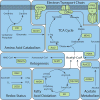Mechanisms and Dynamics of Protein Acetylation in Mitochondria
- PMID: 26822488
- PMCID: PMC4783225
- DOI: 10.1016/j.tibs.2015.12.006
Mechanisms and Dynamics of Protein Acetylation in Mitochondria
Abstract
Reversible protein acetylation is a major regulatory mechanism for controlling protein function. Through genetic manipulations, dietary perturbations, and new proteomic technologies, the diverse functions of protein acetylation are coming into focus. Protein acetylation in mitochondria has taken center stage, revealing that 63% of mitochondrially localized proteins contain lysine acetylation sites. We summarize the field and discuss salient topics that cover spurious versus targeted acetylation, the role of SIRT3 deacetylation, nonenzymatic acetylation, and molecular models for regulatory acetylations that display high and low stoichiometry.
Keywords: acetylation; acylation; metabolic regulation; mitochondria; nonenzymatic; stoichiometry.
Copyright © 2015 Elsevier Ltd. All rights reserved.
Figures




References
-
- Brownell JE, et al. Tetrahymena histone acetyltransferase A: a homolog to yeast Gcn5p linking histone acetylation to gene activation. Cell. 1996;84:843–851. - PubMed
-
- Taunton J, et al. A mammalian histone deacetylase related to the yeast transcriptional regulator Rpd3p. Science. 1996;272:408–411. - PubMed
-
- Roth SY, et al. Histone acetyltransferases. Annu Rev Biochem. 2001;70:81–120. - PubMed
Publication types
MeSH terms
Substances
Grants and funding
LinkOut - more resources
Full Text Sources
Other Literature Sources

